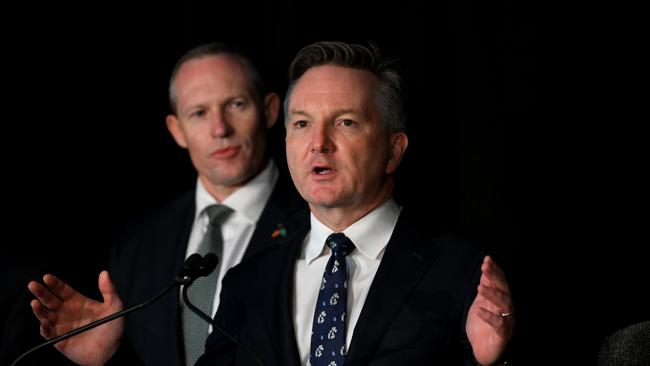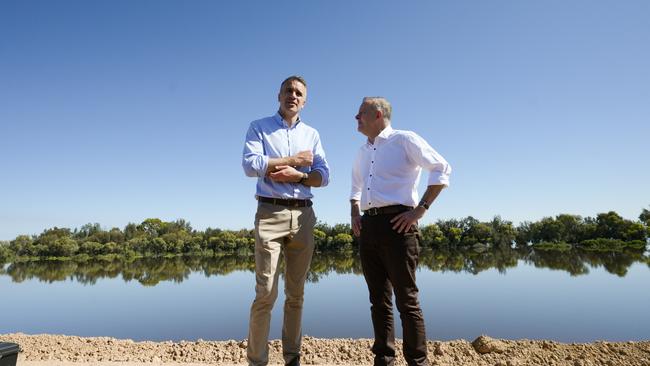On potential energy solutions, too many deny the facts on nuclear
Politicians — even Labor’s realists — continue to tell us nuclear power is uneconomic. But that’s not what the experts say. Why won’t we interrogate it?

It is an endless campaign of urgency, more marketing than science. We muddled our way through the “critical decade” only to be galvanised for the “decisive decade” ahead.
The more you examine science, the more complex the unfolding patterns and policy responses become. The more you interrogate the facts, the more the catastrophist scenarios and simplistic solutions are exposed.
Just because climate scientists predict change does not give licence to journalists and activists to fit up normal weather events as proof of their mooted climate dystopia. Meanwhile the wildest claims of the climate alarmists pass unexamined.
Last Saturday Anthony Albanese visited Renmark, in South Australia’s Riverland, which is experiencing a major Murray River flood that could turn out to be the third worst of the past 100 years, matching 1974 but falling below the 1931 flood, and way short of the 1956 monster. Yet the Prime Minister used the current high river to push his alarmist message.
“Climate change is real,” he said, axiomatically. Then came the hyperventilation: “And I’ve witnessed since I’ve been leader of the Labor Party, I’ve visited areas of tropical rainforests that have never burnt before that have burnt during the bushfires, during the summer of 2019 and 2020, that came after, of course, a period of drought.”
This is a familiar routine of blaming recent natural events on climate change, suggesting this is all worse than it used to be, and boldly ascribing the same causal factor for droughts, floods and bushfires. Most media regurgitates this stuff; like pandemic paranoia, climate alarmism fits into that vortex where media and politicians find mutually beneficial hyperbole.
I asked the Prime Minister’s office which rainforest Albanese claimed had burned for the first time, and it did not answer. Back in that terrible summer there were two prominent references to “unprecedented” burning of rainforests, both of which were quickly debunked when I checked the record.
Guardian Australia ran Australian National University climate academic Joelle Gergis in September 2019. “I never thought I’d see the Australian rainforest burning. What will it take for us to wake up to the climate crisis?” wrote Gergis, a member of the Climate Council. “As a scientist, what I find particularly disturbing about the current conditions is that world heritage rainforest areas such as the Lamington National Park in the Gold Coast hinterland are now burning.”
Soon enough media was alive with the horror of rainforest burning for the first time. Yet in October 1951 The Cairns Post had reported, “A bushfire in Lamington National Park today swept through a grove of 3000-year-old Macrozamia palms … The fire has burnt out about 2000 acres of thick rainforest country.”
So, nearly 70 years earlier, before global warming, rainforest burned in Lamington. Why would media run with fantasy over reality?

Around the same time climate activist and former NSW fire commissioner Greg Mullins told ABC regional radio: “There are fires breaking out in places where they just shouldn’t burn. The west coast of Tasmania, the world heritage areas, subtropical rainforests, it’s all burning. And this is driven by climate change, there’s no other explanation.”
A few minutes of online research put the lie to that. The South Australian Chronicle reported in February 1915 about lives lost in the “most devastating bushfires ever known in Tasmania sweeping over the northwest coast and other districts. The extent of the devastation cannot be over-estimated”. And The Canberra Times in 1982 reported a “huge forest fire” burning out 75,000ha of dense rainforest on the northwest coast.
This fudging in favour of catastrophism is the rule rather than the exception. The lack of curiosity or scepticism from media is astounding, but then even the weather bureau plays along.
In early 2019 when the Bureau of Meteorology proclaimed a new national record for the highest overnight minimum of 35.9C it was dramatic news around the nation. But neither the BOM nor anyone else in the media bothered to reveal that the weather station, at the western NSW location of Noona, had been in place for little more than a year – so all we really knew was that it was the hottest night in Noona for about 18 months.
That same year on January 24 the BOM proclaimed the hottest maximum ever recorded in a capital city – 46.6C in Adelaide. Again, it was big news around the country, but the weather bureau failed to mention the same site had measured a maximum a full degree higher in 1939. The only reason the 2019 record beat the 1939 reading was because the BOM’s temperature “homogenisation” had revised the early record downwards by more than a degree. You do not have to question the BOM’s methodology to wonder why it is not forthcoming with these relevant facts when it announces its new records.
Examples abound. We are constantly told Pacific Islands are about to be swallowed by the ocean when studies show the landmass of islands is growing, both through natural processes and human intervention.
The bracing predictions of Al Gore’s An Inconvenient Truth are conveniently left unexamined – remember sea levels were to rise 6m, hurricanes were going to be more common and snow would retreat from Kilimanjaro – these and other predictions remain stubbornly unfulfilled.
Never mind, because politicians and media leap on every storm, drought, flood and fire as evidence we are experiencing these dire predictions already. This aversion to reality or disdain for truth extends to the energy policies proposed to deal with climate by reducing emissions.
There is a pretence being perpetrated on the public that this nation can power itself, affordably and reliably, on renewable energy plus storage. Worse, it is often insinuated that Australia’s efforts to reduce our 1 per cent share of global emissions can somehow change the weather, even though global emissions continue to rise.
Addressing the energy cost and supply crisis this week, Climate Change and Energy Minister Chris Bowen said: “This crisis is caused by coal and gas prices, anybody who says it’s caused by renewables is lying, and that needs to be called out, renewables are the solution to this crisis, not the cause.”
He had better tell Reserve Bank of Australia governor Philip Lowe, who had this to say last month: “It is difficult to make predictions here, but it’s probable that the global capital stock that is used to produce energy will come under recurring pressure in the years ahead. If so, we could expect higher and more volatile energy prices during the transition to a more renewables-based energy supply.”
Sounds a hell of a lot like the transition to renewables is putting upward pressure on prices. This is obvious when you consider the massive investment required in intermittent generation, regulated transmission and storage, all of which need to be funded by taxpayers and consumers.
This was made plain by Alinta Energy chief executive Jeff Dimery last month when he predicted price rises of at least 35 per cent for consumers. “The cost of the transition is going to be for a raft of reasons more expensive than it otherwise would have been a few years ago, and we need to make the public aware of the cost of transition,” he told Ross Greenwood on Sky News.
Are Lowe and Dimery telling lies? I think not. Bowen wants to pretend that a trillion-dollar transition away from fossil fuels to a renewables-plus-storage model will be cheap and painless.
In fact, the evidence suggests it is impossible. The International Energy Agency says almost half the reductions to get to net zero by 2050 globally will have to come through “technologies that are currently at the demonstration or prototype phase” – you only have to look at the energy crises facing every economy going down the renewables path to see this reality playing out.
Yet even on potential energy solutions, too many deny the facts. Bowen, Albanese and even modern Labor’s nuclear energy realist, South Australian Premier Peter Malinauskas, argue a domestic nuclear energy industry would be uneconomic – “the most expensive form of energy” – for Australia. This too, flies in the face of verifiable facts. The IEA’s 2020 analysis of electricity generation costs found that “electricity from the long-term operation of nuclear power plants constitutes the least cost option for low-carbon generation”. The politicians cite “most expensive” when the apolitical global experts talk about “least cost” – yet our national debate fails to interrogate these issues.
On current technology the great advantage of nuclear, despite considerable capital costs, is reliability, durability (a new plant will last at least 60 years) and the leveraging of existing transmission infrastructure. By comparison, renewables require massive overbuilds (so capacity triples demand to cover intermittency across different locations), battery storage (which is inadequate and prohibitively expensive), firming generation (probably gas) and at least 28,000km of transmission lines to link generation projects across vast distances. Additionally, solar panels and wind turbines will need to be replaced every 15 to 20 years.
So the initial capital cost of wind generation needs to be multiplied four or five times before it can be compared to nuclear. And nuclear is getting cheaper and easier with the development of small modular reactors.
If we have regard for the facts, and we want to eliminate greenhouse gas emissions, no politician ought be able to reject nuclear on cost grounds. But there is far too little focus on reality right across this debate.






Facts and truth are loose concepts in the climate alarmists’ arsenal. As we pass one “tipping point” declared a decade or two ago, we are warned of new tipping points a decade hence.